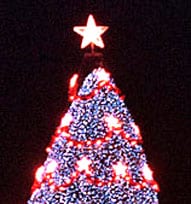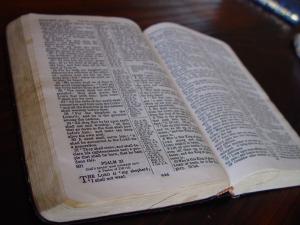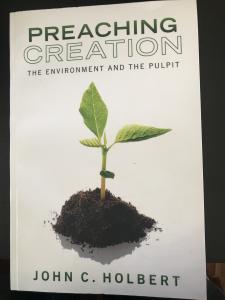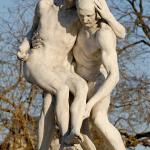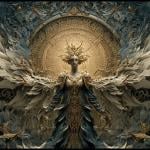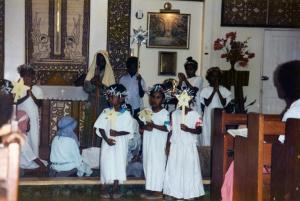 Not a single person reading this essay has failed to have the experience of the mash-up Christmas pageant. You know the one: the living crèche is crammed into the nave of the church, tiny cows lowing, little sheep baaing, the angel hovering precariously above the stable, lovely Mary, humble Joseph sitting by the wooden manger, adoring the child, either a real baby or a bright-eyed doll, while three kings in regal crowns kneel with their gifts of chocolate golden coins, a chest from Mom’s jewelry draw, and that old vase that was recovered from the attic, now become the bearer of myrrh. And over the entire scene a bright tinfoil star shines its reflected light. What has happened here has been happening in such recreations for hundreds of years, preceded by nearly two millennia of attempts to slap the stories of the birth of Jesus together to cover over the very stark differences between Matthew’s and Luke’s accounts, not to mention the complete absence of such tales from Mark and John. As early as the third century CE, harmonies of the Gospels began to appear, and for next 1800 years, such mash-ups have been the norm at Christmas.
Not a single person reading this essay has failed to have the experience of the mash-up Christmas pageant. You know the one: the living crèche is crammed into the nave of the church, tiny cows lowing, little sheep baaing, the angel hovering precariously above the stable, lovely Mary, humble Joseph sitting by the wooden manger, adoring the child, either a real baby or a bright-eyed doll, while three kings in regal crowns kneel with their gifts of chocolate golden coins, a chest from Mom’s jewelry draw, and that old vase that was recovered from the attic, now become the bearer of myrrh. And over the entire scene a bright tinfoil star shines its reflected light. What has happened here has been happening in such recreations for hundreds of years, preceded by nearly two millennia of attempts to slap the stories of the birth of Jesus together to cover over the very stark differences between Matthew’s and Luke’s accounts, not to mention the complete absence of such tales from Mark and John. As early as the third century CE, harmonies of the Gospels began to appear, and for next 1800 years, such mash-ups have been the norm at Christmas.
Well, so what, I hear you say? Why worry about such elitist nonsense, attempts to pry apart what has been well glued together in our hearts and minds by the church pageants, the beloved hymns, the readings of the Scriptures themselves that slip back and forth between the four Gospels, providing the appearance of continuity among them all if not the proven fact of it? Only nasty liberal scholars like me would have the temerity to assault our Christmas memories and demean what has been most memorable to us in our church life. Last night (Dec.15, 2020), I lead a zoom discussion of all this, and the responses were quite instructive. One person said that she always remembered in her church the emphasis on the “kindly innkeeper” who graciously directed the holy couple to his stable, since unfortunately his inn was full that night. In reply, my preacher wife told me that she was always told that the innkeeper was, on the contrary, “hard-hearted and calloused,” slamming the door in the couple’s faces, forcing them to find the barn or stable, or whatever it was, on their own. Luke’s text reads in fact, “…they laid him in a manger because there was no place for them in the inn” (Luke 2:7). That is all. Whether the innkeeper was a wretch or an angel is not even suggested, but the ongoing power of Christian midrash has in reality created in the minds of readers the contrasting portraits of the keeper of that inn who is not mentioned at all.
And leads me to the subject of this essay: is it important at all to attempt to capture any supposed history that may lie behind these old stories, or is the poetry of it all that matters in the end? I want to offer one vote (employing the metaphor of the moment) for poetry over history. I do not wish to denigrate the enormous energy expended by those who have spent scholarly lives on the prowl for “what really happened,” but I am always afraid that that sort of question has the distinct possibility of clouding over the magical poetry that has shone forth from these tales for two millennia. And in addition I wish to say that a healthy imagination, when employed in the face of the stories, is more important to me than a seeking after possible historical truth. I say this in spite of my long-time concern with reading the text as we have it. Even though I know well that an innkeeper is not even mentioned by Luke in his account, to characterize that non-existent person as nasty or kind has a potent flavor to it that I do not wish to lose. However, in the search for history, I want to point to another example from the Christmas mash-up, that astonishing star over Bethlehem.
Matthew says it this way: “In the time of King Herod, after Jesus was born in Bethlehem of Judea, magi from the East came to Jerusalem, asking, ‘Where is the child who has been born king of the Jews? For we have observed his star at its rising (or “in the East”), and have come to pay him homage’” (Mt.2:1-2). And later, after Herod, terrorized that some king may have been sent to supplant him, has sent the magi away with the command that they tell him where this child is, Matthew continues, “When they had heard the king, they set out; and there, ahead of them, went the star that they had seen at its rising (or “in the East”), until it stopped over the place where the child was. When they saw that the star had stopped, they were overwhelmed with joy” (Mt.2:9-10). Now here is a most peculiar star indeed! The tale relates that the magi, recognizing it as “his” star, that is the “king of the Jews’” star, follow it westward, and while they are chatting with the wily and cruel Herod, the star apparently waits patiently for them until the conversation ends, and then continues its movement until it stands still right over the house where Jesus has been born. Like a faithful dog accompanying and both leading and following them, the star acts unlike any star in the world’s history.
In response to the tale of this star, any number of ancient celestial phenomena has been suggested as the true story of this heavenly body. According to Chinese records, a supernova (an exploding star or star cluster) appeared in the sky over China in 5BCE. Another guess is the appearance of Halley’s Comet, that object that has swung over the earth every 75 years or so throughout recorded history. Its coming occurred in 12/11BCE, say certain astronomers. And others suggest a planetary conjunction, that is to say the “joining” of Jupiter and Saturn, the two largest planets in our tiny Sun system, appearing close together to our eyes in the night sky, though in reality they are of course millions of miles apart. Such a conjunction occurred, some scientists say, in 7BCE, and they add that a Jupiter/Venus conjunction happened in 3BCE. All well and good, I say, but finally irrelevant to the poetry of this amazing star. This is hardly a comet or a supernova or a planetary conjunction; it is “his star,” and it performs in the sky like no other star before or after. In fact, it sounds rather more like the actions of the sun above Aijalon in Joshua 10, a sun that refuses to set on a certain day in order that the Israelites might complete a military victory over their enemies, the Amorites. We now know what would happen if our sun actually stopped in the sky; we would all fly right off the earth en masse! Science cannot help us with the poetry here; the sun stopped because the story needs it to stop. In the same way, the star rose and led the magi to Jerusalem, then waited for their chat with Herod, finally stopping over the house where Jesus was to be found. This is poetry, not science; this is poetry, not history.
To recognize the poetry of these stories is not in any way to diminish them as powerful claims on our lives. The tales of the birth of Jesus in Bethlehem remain today and always the touch stone of our faith that God has come to dwell with us, to save us from our selfish desires and cruel injustices, to remind us that on our own we will fail miserably in the work God has called us to perform, but with God there is every chance that the cosmos that God created and loves may find wholeness and hope once again. I need no historical corroboration of the details of these grand stories to shore up my faith; such need is a grasping at Enlightenment straws, to reduce truth to historical, geographical, astronomical truth only. It is in the end completely poverty-stricken to so limit the truth available to us. Love the poetry! Rejoice in the poetry! Live by the poetry! It is what our fabulous Bible has given to us, and it is far more than enough.
(images from Wikimedia Commons)